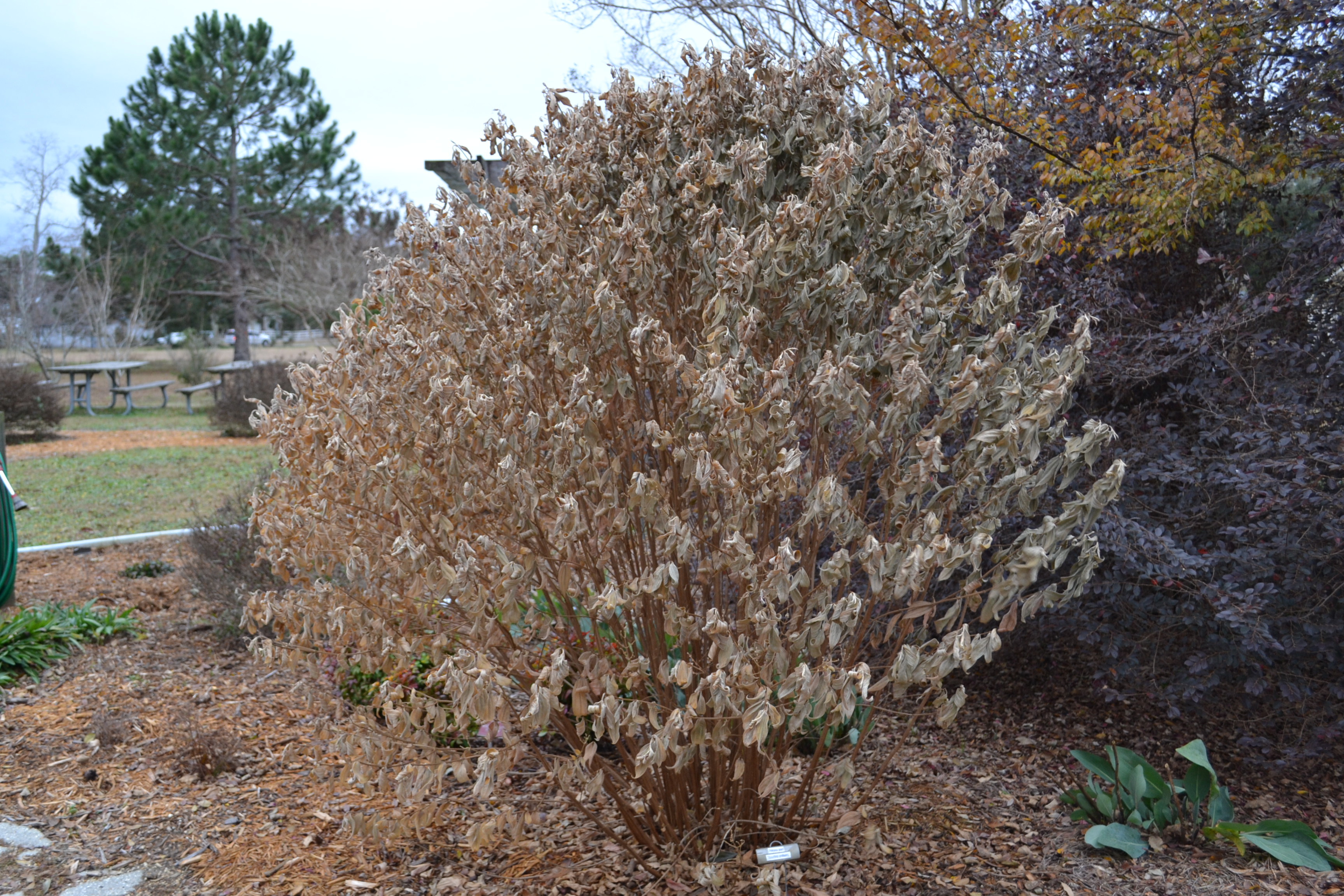
by Beth Bolles | Dec 2, 2014
Our recent cold weather was not only a surprise for many locals but also for many plants that still had plenty of green growth. After a couple of nights of freezing temperatures, even deciduous trees that had not dropped their leaves, look a little ratty.
Since it is just the beginning of December and we are likely to have many more days this winter with cold weather, now is not the time to react to plants that were damaged. There are a few exceptions of plants that you can prune back, but in general patience is the key for the winter garden and cold-damaged plants.
Here are a few guidelines.
Unless planted in very protected spots, annuals like coleus and angelonia were killed by recent cold air. You may remove these plants or cut them back close to the group to make garden areas look neater. You may want to add some new winter annuals to brighten up these spots.
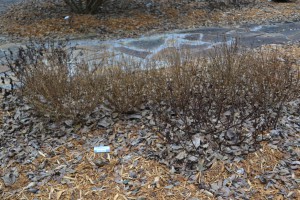
Warm season annuals can be removed from the garden.
Both young and mature citrus trees experienced injury since many plants still had tender growth. Do not prune out any damage at this time. We will wait until next Spring to learn where the growth will resume and then prune as necessary to remove dead branches.
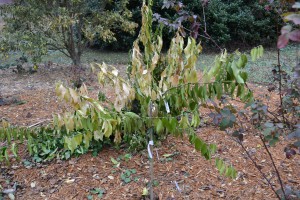
The tender growth on a young Meyer lemon was damaged by cold air.
As expected, the above ground portions of flowering perennials were severely injured by cold air. It is best not to prune these back now since the layer of branches and foliage may help insulate lower branches that could still have some life. If you are not able to tolerate the look of cold-damaged perennials in your garden, consider only pruning half of the plant just to make a neater appearance in the garden. When warm weather returns next year, we may be surprised to see growth resume on lower stems.
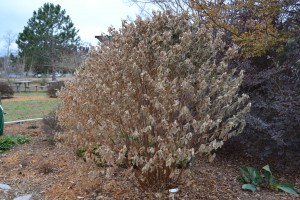
Many flowering perennials like Tibouchina will return from the ground next year.
Deciduous trees that would have normally dropped leaves before the cold have full canopies of dead leaves. Trees will eventually drop these leaves aided by winter winds and rainfall.
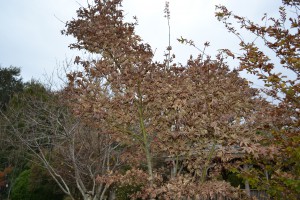
This Japanese maple will eventually drop it’s cold-damaged leaves and offer attractive bark and structure in the winter garden.
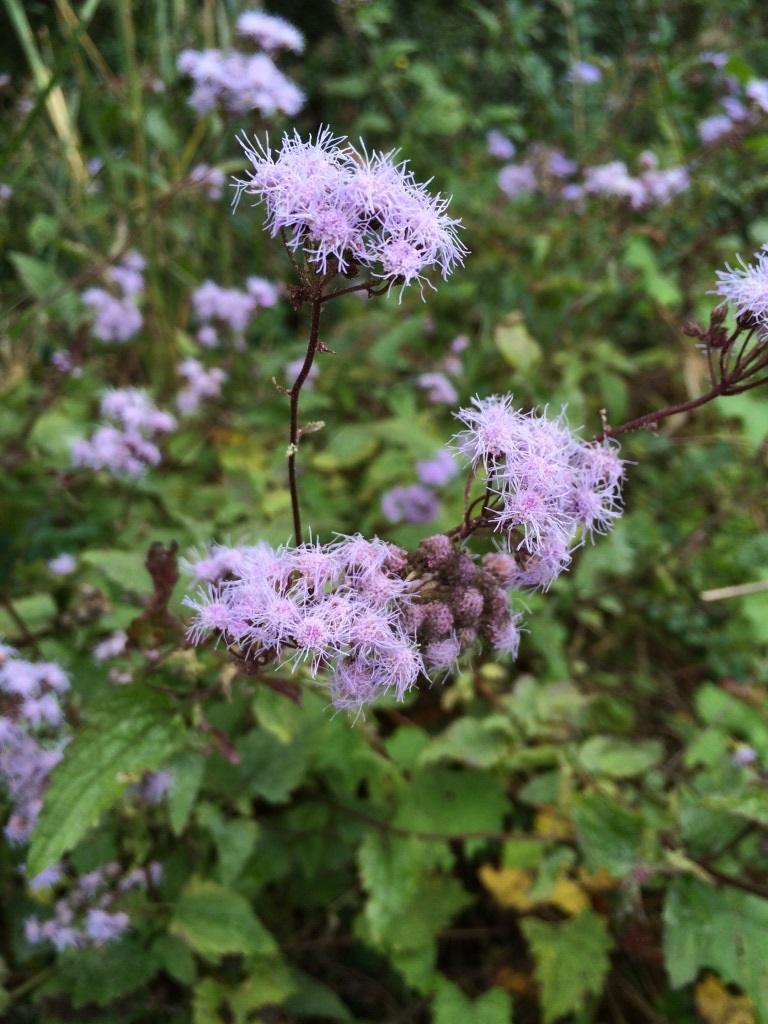
by Mary Salinas | Nov 18, 2014
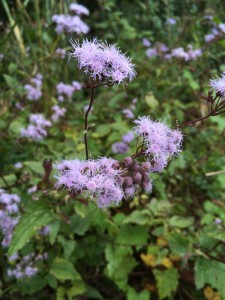
Blue Mistflower – Image Credit Mary Derrick, UF / IFAS
Here’s a beautiful native perennial wildflower that is easy to grow and generally available in the independent nursery trade. In the wild, you can encounter them at the edges of woodlands and ponds as they prefer moist areas. Blue mistflower, Conoclinium coelestinum, performs well as a perennial in the home landscape but does spread easily by seed and will spread in the garden. It also spreads through underground rhizomes which allow it to form large clumps. This is an advantage for the informal garden, however, the gardener who prefers a more formal look will have a bit more maintenance in controlling that spread.
The abundant flowers look like bluish-purple puffballs on the top of the stems. The color is unusual and adds a striking touch in the garden. The bloom season is mid-summer to mid-fall. Butterflies are frequent visitors, making this an excellent addition to your butterfly garden.
Blue mistflower has a full rounded form and will grow to 3 feet under optimum conditions. Leaves are opposite and have a triangular shape. Growth and blooming is best in full sun to part sun conditions.
Give it a try!
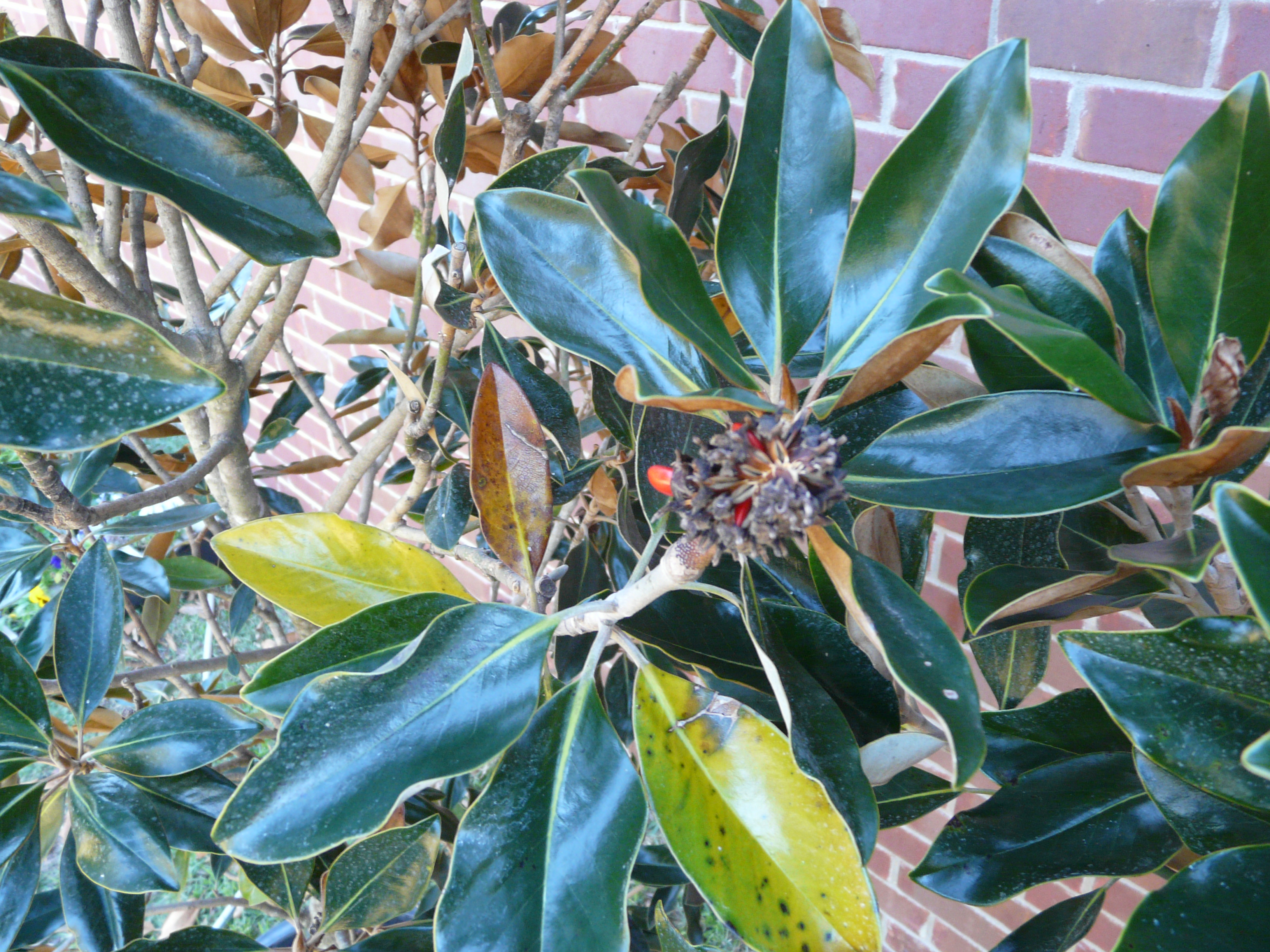
by Larry Williams | Nov 11, 2014
As the season changes, plants change as well. This is true in evergreen and deciduous trees and shrubs as well as our lawn grasses.
The cooler night temperatures and the shorter day length of fall result in changes in the physiology of many of our landscape plants and lawn grasses.
It’s common for azaleas to lose a few leaves now. These are the older leaves on the stem near the center of the plant. They turn reddish or yellow and drop from the plant. This is normal from now until spring. However, if the younger leaves, those nearest the tip of the shoot, turn yellow or brown there is cause for concern. Poor drainage, lack of water or alkaline soils may cause this condition.
Yellow leaves may appear on camellias, gardenias, cherry laurel and oleanders. Again, as with azaleas, these are the older leaves on the stem near the center of the plant. It’s normal for these leaves to drop from the plants now until spring. However, do not confuse scale damage on camellias for normal aging of leaves. Scale insects feed on the lower surface of camellia leaves causing them to become splotched with yellow.
Many of the leaves on sycamore trees have changed from green to brown. Although this phenomenon occurs every year, it’s not caused by a change in day length or temperature. This is not a true seasonal change. It’s the result of insects feeding on the leaves. By the time the damage is visible, there is little that can be done to correct the problem. However, the problem will take care of itself since sycamore trees will soon be dropping their leaves.
Lawn grasses also experience some seasonal changes. The growth rate of lawn grasses slows in the fall. Although this slowdown in growth means less mowing is required, it also means that lawns will not be as attractive as they were during spring and summer. Because of this reduced growth rate, grasses cannot produce enough new leaves to replace the leaves that are dying. The end result is a dull, yellow-green lawn.
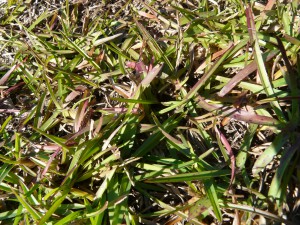
Normal seasonal color change in centipedegrass lawn from green to reddish purple.
Photo by Larry Williams, Okaloosa County Extension
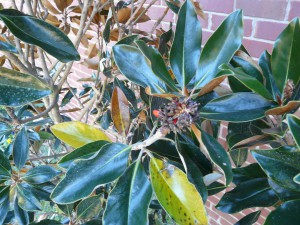
Normal seasonal color change on older ‘Little Gem’ Magnolia leaves. Photo by Larry Williams, Okaloosa County Extension
Numerous reddish-purple blades throughout the lawn may be visible now as well. Cooler temperatures, injury to the leaf blades from foot traffic, mowing equipment, vehicles, etc, can cause this. It also could be caused by lack of potassium or phosphorus but is more likely the result of cooler temperatures, especially if it did not show up until fall.
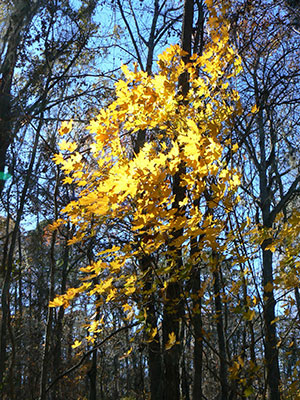
by Taylor Vandiver | Nov 11, 2014
As winter approaches, short days and cool temperatures cause many plants to slow down and enter a suspended growth phase known as dormancy. Dormancy in plants is similar to the way bears hibernate during the winter. You may be asking yourself what is dormancy? And how can I get in on that? Well, to be honest, there isn’t an all-encompassing answer. It seems that plants (and bears) are keeping that secret all to themselves.

Fall foliage of Florida maple. Photo courtesy UF/IFAS.
Now that winter is indeed coming, deciduous plants start to breakdown proteins and other chemicals in their leaves and store them in the buds, bark and wood for growth next spring. Many deciduous plants lose their leaves as they become dormant, such as maples and dogwoods. Evergreen plants such as pine trees and camellias keep their leaves all winter.
There are actually two types of dormancy during the winter. One is called endo-dormancy. In endo-dormancy, the plant refuses to grow even under hospitable conditions. In endo-dormancy, something inside the plants is inhibiting growth. The other form is eco-dormancy and occurs when the plant is ready to grow, but the environmental conditions are not favorable (usually too cold). Short days and freezing temperatures in the fall induce endo-dormancy in the plant, which occurs first.
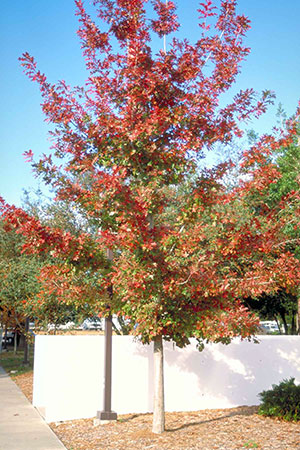
Shumard oak showing off its fall colors. Photo courtesy UF/IFAS.
As the plant enters endo-dormancy, it tracks chilling hours to chart the passage of the winter. Chilling hours are the time when temperatures drop below 45 degrees Fahrenheit. The number of hours required for chilling varies for different plants. Many people think the plant is tracking hours below freezing. However, hours below freezing have no effect on chilling, but will increase cold hardiness. If warm weather occurs before the plant completes its chilling requirement, no growth occurs. Chilling and endo-dormancy normally prevent plants from beginning growth during warm spells in the middle of the winter. Not all hours above freezing are equal. Temperatures between 35 and 45 degrees Fahrenheit seem to be most effective. Temperatures just above freezing and above 50 F are less effective and temperatures above 60 F often have a negative effect on chilling.
After a plant has checked off its chilling hours it is no longer in a state of endo-dormancy. It is now in eco-dormancy. The plants are dormant only because of cold temperatures. Warmer weather will cause plants to yawn, make that final stretch, and begin to grow. Growth first becomes apparent when buds swell and then green tissue emerges from the bud. However, plants actually begin growing before we notice their swelling buds. So this winter when your plants start to shed their leaves don’t be frightened, they may just be taking a much deserved rest in preparation for a brilliant show come spring.
Please contact your local extension office for more information.
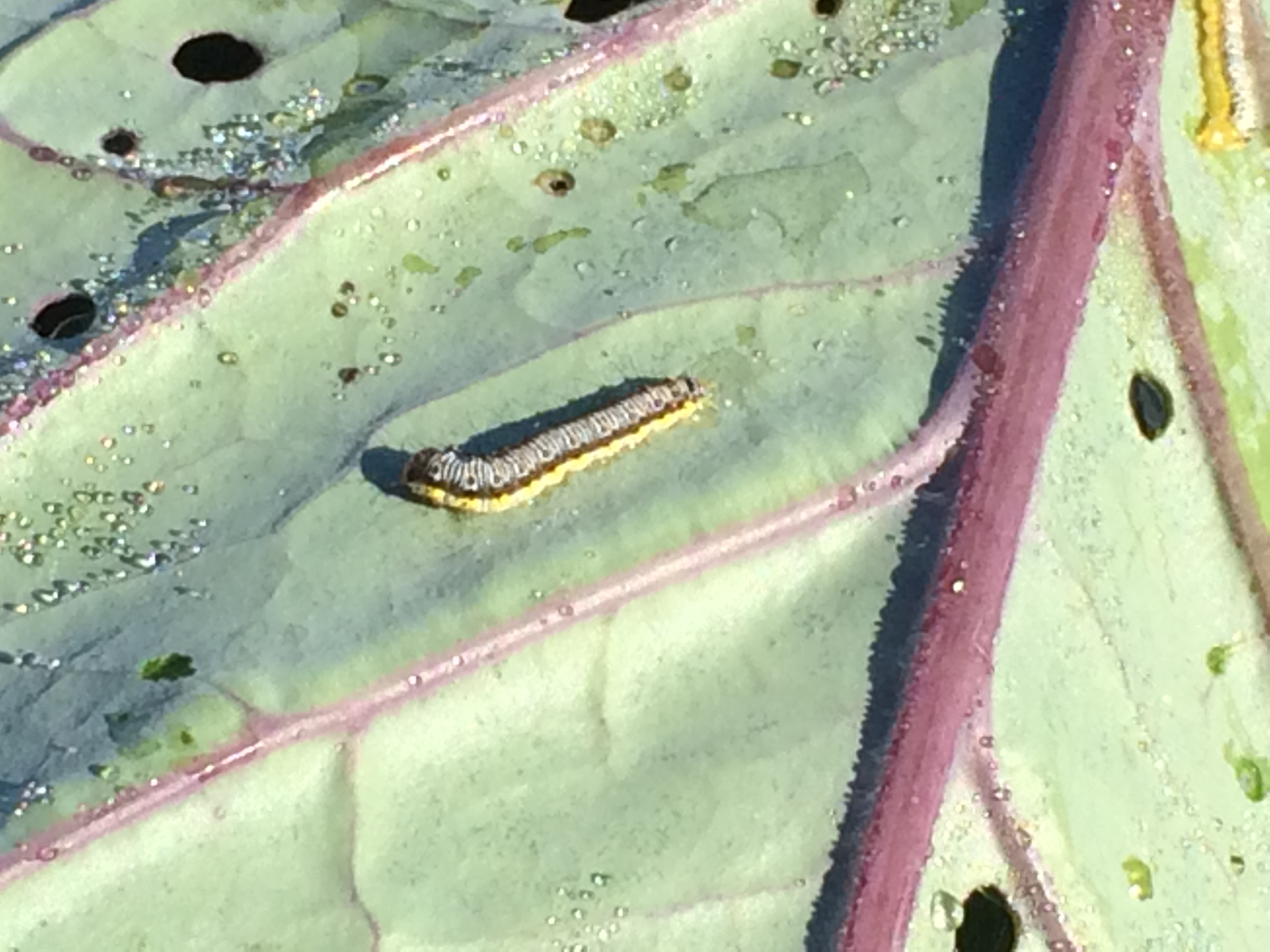
by Blake Thaxton | Oct 21, 2014
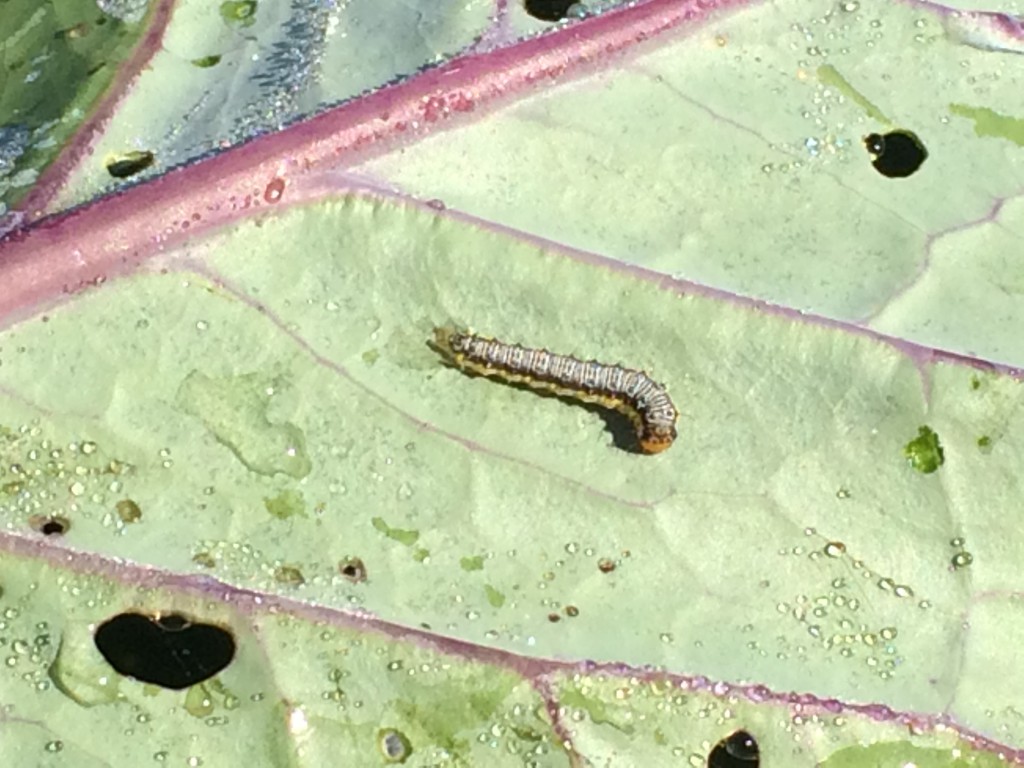
Cross-Striped Cabbageworm – Photo credits: Blake Thaxton
Panhandle gardeners have their fall gardens planted and our growing rapidly. What the gardeners may start noticing is shotgun damage to cabbage leaves in their garden. The suspect for this damage is the Cross-Striped Cabbageworm.
The Cross-Striped Cabbageworm have black and white markings on the back of the caterpillar and a bright yellow stripe on each side. This particular caterpillar feeds in cluster and maybe limited to a hot spot of a few plants in the garden or production area. They feed on tender parts of the cabbage including the terminal bud and can feed into the head once heading is initiated.
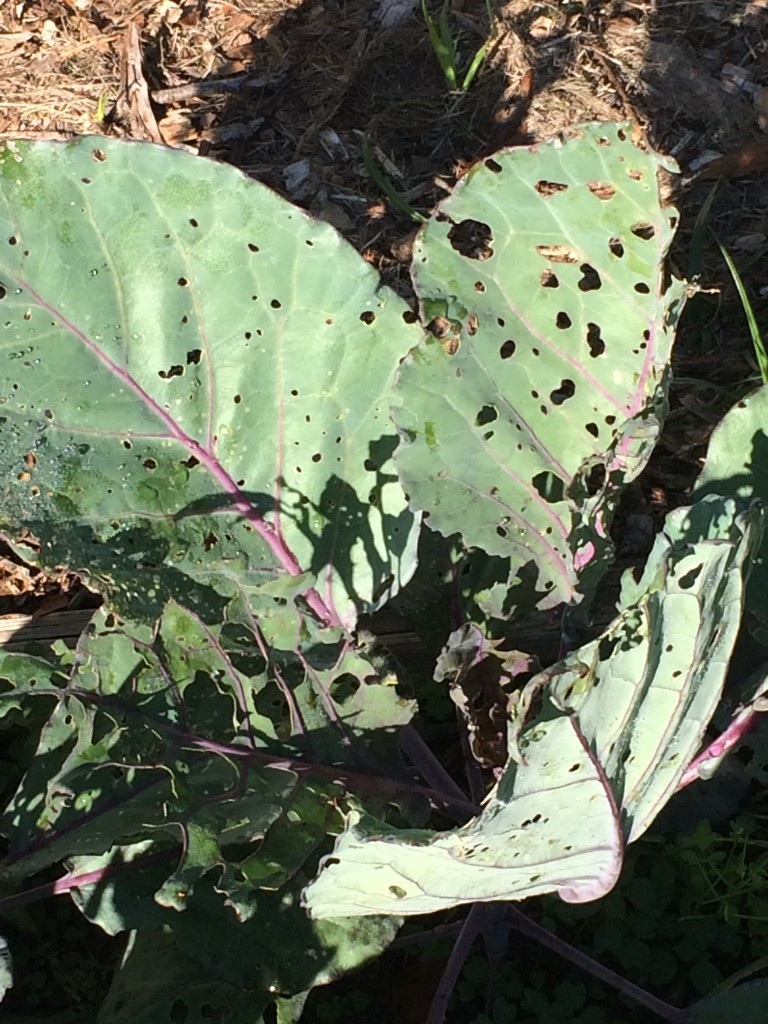
Damage caused by Cross-Striped Cabbageworm – Photo Credit: Blake Thaxton
With all pest control the three levels of control should be used:
- Level 1: Systems-based practices – weed control of pest host weeds
- Level 2: Mechanical and physical practices – A barrier, such as a light cloth that still allows enough light, can be used when the plants our young to prevent the moths from laying eggs on the cabbage.
- Level 3: Soft chemical & other materials – Bt (Bacillus thuringiensis) products can be used on the small-sized caterpillars. Harsher chemicals can kill the adults but in a garden situation picking them off and disposing them in a bucket of soapy water will do the trick as well.
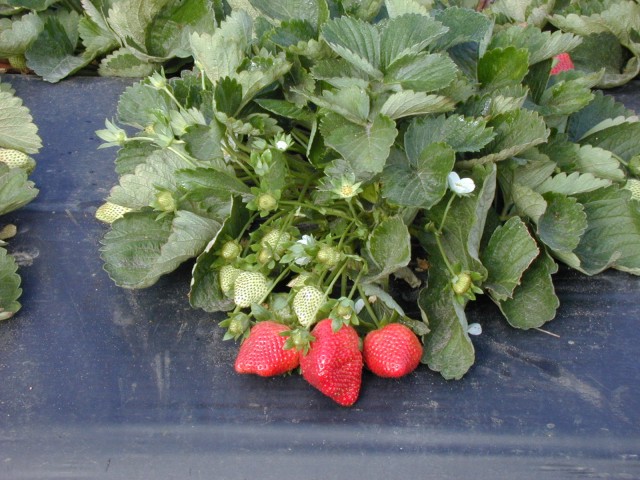
by Matthew Orwat | Oct 14, 2014

Sweet Charlie Strawberry. Credit: C.K. Chandler, UF IFAS Extension
Now is the time for Northwest Florida gardeners to plant strawberries for bountiful production of fruit beginning in January and continuing into May. The following procedure will lead to a successful strawberry garden if followed:
The best location for strawberry production provides well-drained, moist, sandy soil with substantial organic matter. It must not be too wet. A fertilizer scheme of 2 lbs of a 6-8-8 fertilizer per 100 sq ft should be broadcasted over the plot, and spaded or disked in. Prepare the bed by leveling out the soil. Commonly, a preferred system is the development of a hill system, which entails making a raised bed 6-8 inches high and 24 inches wide. A raised bed can be filled with well-rotted compost mixed at a 50:50 rate with soil. After bed preparation, provide another application of fertilizer in a single, narrowband in the middle of the bed, 4 to 8 inches deep, but DO NOT apply fertilizer directly below the plants, as the fertilizer may burn the young transplants. Do not use fertilizer with more than 6% nitrogen on strawberries, so that they have less chance of burning and greater chance of setting sweet, quality fruit.
Short day, certified disease free plants for Florida such as Sweet Charlie and Camarosa should be purchased from a reputable nursery.
If growing the plants using plastic mulch or grow fabric, put drip irrigation underneath in the form of drip emitters or bubbler type soaker hose.
When setting out the transplants:
- Keep plants moist before planting
- Spread roots out in fan-shape
- Set plants in moist soil at the correct depth. Do not cover the plants crown with dirt or leave its roots exposed above the soil.
- Space plants 12 to 18 inches apart.
- Pack the soil firmly around the roots, then sprinkle with water. Overhead sprinkling may keep the tops from drying out until the roots can get established.
For best results, strawberries should be mulched. Black polyethylene plastic mulch at 1 to 1½ mil thick is best (completely cover the top and sides of bed before planting). Be sure the bed is firm, formed correctly, moist, and fertilized adequately. Place soil on the edges of the plastic to hold it in place. Cut slits in the plastic for the transplants.
When using alternatives like straw, bark or other natural organic materials mulch to a depth of 1 to 2 inches, but do not completely cover the plant.
For more information on growing strawberries contact your local UF IFAS Extenison office or read this publication on strawberry production.

















